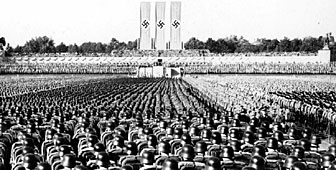Swiss supplied arms to Nazi war machine

New studies probing Switzerland's wartime past have found that the country supplied munitions to the Nazis at the expense of the Allies.
Seven studies released on Friday by the Independent Commission of Experts (ICE) show that the lion’s share of Swiss munitions exports went to the Axis powers.
The studies, the last of 25 produced by the ICE, also confirm that Switzerland acted as the main clearing house for Nazi gold even though the Swiss central bank knew that some of it was stolen from victims.
The ICE presented its final report in Bern on Friday, after a five-year investigation into the volume and fate of assets moved to Switzerland before and during the Second World War.
The report on arms revealed that from 1940 to 1944, 84 per cent of Swiss munitions’ exports went to Axis countries. The remaining 16 per cent was split between the Allies and neutral countries.
German pressure
In the pre-war years, by contrast, most Swiss exports of war materials went to the Western powers. After the outbreak of hostilities, Bern diverted its arms’ supplies amid Nazi threats to cut coal exports to Switzerland.
After 1941, Germany became the main market for Swiss weapons’ components benefiting some companies, which made fat profits.
Indeed, some companies – notably Oerlikon Bührle, Dixi, Hispano Suiza and Waffenfabrik Solothurn – gave priority to foreign sales rather than the domestic market because far higher prices could be obtained from exports.
However, the country itself gained little from supplying the Nazis – munitions’ exports depleted reserves of raw materials and frequently breached neutrality laws.
Processing Nazi gold
Switzerland was also the main clearing house for transaction of German gold, according to the ICE.
The issue was the subject of an earlier study by the commission. This time around it disclosed that 77 per cent of all the Reichsbank’s gold deliveries abroad during the war were carried out through Switzerland.
The lion’s share (94 per cent) of gold deliveries handled by Switzerland went through the central bank. Those deliveries, said the commission, amounted to SFr1.7 billion. It wasn’t until 1945 that the SNB bowed to Western Allied pressure to stop accepting deliveries of gold from Germany.
This was despite the fact that the Swiss central bank knew that some of the gold had come from victims of the Nazi’s extermination policy.
Anti-semitism
Beyond their dealings with the Reich, Swiss banks were found to have supported the Nazis programme of Aryanisation. The ICE found that “several bank directors were infused with a latent anti-Jewish sentiment, which in certain cases, turned into anti-Semitism”.
Credit Suisse and the Swiss Bank Corporation, for instance, had expressed reluctance at the prospect of working with Jewish financiers. While the Union Bank of Switzerland went so far as to hire a Nazi party member to represent its interests in Germany.
However, the report makes clear that, in some cases, banks helped Jews transfer their assets to Switzerland and place them beyond the Nazis’ reach.
Violating neutrality
The ICE found that Switzerland’s foreign trade policy clearly violated the country’s self-declared neutrality.
On the one hand it declared itself politically and economically neutral, but on the other its main export market was Germany, and export credits issued by the state effectively meant it was actively financing the Nazi war machine.
Switzerland continued trading with the Western Allies, but after 1941 found itself surrounded by Axis powers and the balance of export trade tipped in Germany’s favour.
Final studies
The ICE released the final batch of seven studies on Friday. They marked the last of the 25, which the Commission, headed by Swiss historian, Jean-François Bergier, had been mandated to carry out to shed light on the country’s wartime past and its links with Nazi Germany.
Earlier studies had focused on a number of issues, including Switzerland’s treatment of refugees during the war, Swiss industry’s close and lucrative ties with the Third Reich and the use of forced labour in Swiss companies subsidiaries in Germany.
A team of 50 historians, researchers and experts spent five years preparing the studies. The ICE has been controversial since its creation, with associations of wartime veterans and right-wing parties claiming that it was out to establish a collective guilt of the Swiss where none was needed.
by Jonathan Summerton

In compliance with the JTI standards
More: SWI swissinfo.ch certified by the Journalism Trust Initiative









You can find an overview of ongoing debates with our journalists here . Please join us!
If you want to start a conversation about a topic raised in this article or want to report factual errors, email us at english@swissinfo.ch.